THCA, or tetrahydrocannabinolic acid, is a kind of chemical that is also known as a cannabinoid. The unique thing about this component is it has several medicinal uses. People habitually heat it to change it into Delta-9 THC or tetrahydrocannabinol (THC), another kind of cannabinoid. A couple of kinds of cannabis plants, namely, hemp and marijuana, are a vital portion of the same species. You will find THCA in the flowers of cannabis plants. To get more THCA, it seems feasible to use fresh cannabis plants instead of dried plants, particularly raw cannabis buds.
Getting THCA
To get THCA, you need to buy hemp, and after you heat it up, it will find it to be changing into THC, and it makes people get high. Commonly, people opt for this method when they fail to get access to marijuana. At times, people also use this process if they live in a place where it is unlawful to use marijuana.
How is hemp different from marijuana?
The factor that makes hemp different from marijuana is the amount of THC it contains. Marijuana contains more THC, but hemp is considered to have less than 0.3 percent of THC. Though hemp lacks enough THC that can cause people a high, it doesn’t contain THC.
Can you get a high using THCA?
THCA lacks the psychoactive properties when you get it in its natural condition. The molecular structure of this component does not allow it to bind to the brain receptors that remain liable to make people feel high. Nonetheless, this notion turns true only when people consume THCA raw, like freshly harvested cannabis.
Notable benefits of THCA
If you take THCA, you will find it to have several neuroprotective effects, which means it will protect your brain. Additionally, THCA also exhibits powerful anti-inflammatory properties. It can slow down the advancement of cancer cells, lessen nausea, stimulate hunger levels, and might also provide solace from seizure disorders.
Popular forms of THCA
You will find THCA in various forms:
- A patch
- The actual flower
- Diamond crystals
You will also find THCA in an edible form, such as gummies, and many people opt to eat the buds raw only.
THCA flowers
A different way to get THCA is a cannabis flower. Most often, people smoke or vape the THCA flower. If THCA is endorsed in the form of a flower, people can sell it in the form of hemp. A few people consume THCA flowers for medicinal purposes, too.
THCA diamonds
When you get THCA in small crystals, you can assume it is THCA diamonds. To make them, you need to extract THCA from cannabis before adding pressure and heat to form crystals known as diamonds. You can add these crystals to marijuana to raise the levels of THC to get a greater high. Many people love this, as when they get THCA diamonds, they can make their marijuana last for a long time.
THCA patches
You can put THCA into patches and stick it onto your skin. The THCA patches deliver consistent THCA amounts into people’s bloodstream without making them feel high.









